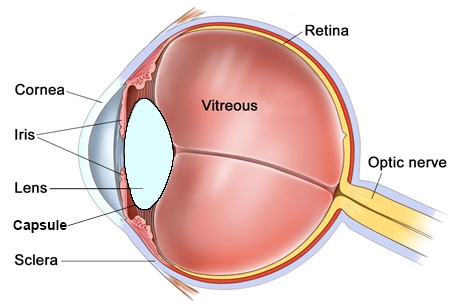
Overview
Just as you have a lens in glasses to focus, there is also a lens inside the eye to focus. This lens is held in position by a thin capsule. When the lens becomes cloudy it is known as a cataract. At the time of cataract surgery a hole is made in the front of the capsule in order to remove the cataract. The remainder of the capsular bag is left behind to help hold the new lens in the correct position.
In approximately 10% of people, after cataract surgery, the remaining posterior part of the capsule can also become cloudy. This blurs the vision, just like the original cataract did, and cannot be corrected with glasses. Some people describe this blurring as being like the original cataract returning. This is not the case, it is simply the capsule that is left behind after surgery, becoming cloudy over time.
Fortunately, this posterior capsular opacity (PCO) can be treated in clinic with laser, and does not require surgery.
What does laser treatment involve?
Laser treatment is performed in the outpatient department. You will have drops to dilate the pupil. These take 15 minutes to work. You will subsequently not be able to drive for 3-4 hours, until the drops wear off. You will then be brought into the laser room where you will have some anaesthetic eye drops instilled to numb the eye. These last 30 minutes. The laser is done whilst you are sitting upright, just like a normal examination in the eye clinic. A special contact lens will be placed onto the eye to focus the capsule. As the laser proceeds you will see a flashing light. This is completely painless. The procedure takes approximately 5 minutes. Your only instruction will be to look straight ahead. At the end of the procedure the vision may be a bit blurred, and you may be aware of floaters (seeing objects in the field of vision), but by the next day your vision should be better than before surgery. There are no special instructions post-operatively. You can do sports, including swimming as normal. Often a follow up appointment is not necessary, but on occasions we ask some patients to return to the department for further visit.
What are the risks of YAG Laser Treatment?
The risks associated with YAG laser capsulotomy are incredibly small. However, all procedures carry some risk. The most common risk is that there may be some inflammation or bruising of the eye temporarily afterwards (1:20). This is usually minor, but may cause the eye to be red, with blurred vision and photophobia (bright lights hurt the eye). This can be treated with drops. In about 1 in 100 cases the retina (photographic film of the eye) may become swollen, causing blurred and distorted vision. This would need to be treated with drops, sometimes for months to improve. Uncommonly people notice increased floaters in the eye after treatment. This is often the natural floaters of the eye becoming clearer or sharper having been stirred up by the laser. These are harmless and do not need treatment, but can be removed if distressing. Rarely the lens implant may be damaged by the laser, causing symptoms of glare or blurred vision (1:1000). Rarely the retina may detach (1:1000). This would require urgent surgery to prevent loss of vision or to improve vision. The signs of this would be a sudden onset of new floaters in the eye, or a large shadow growing across the eye over hours or days, like a curtain being drawn.
